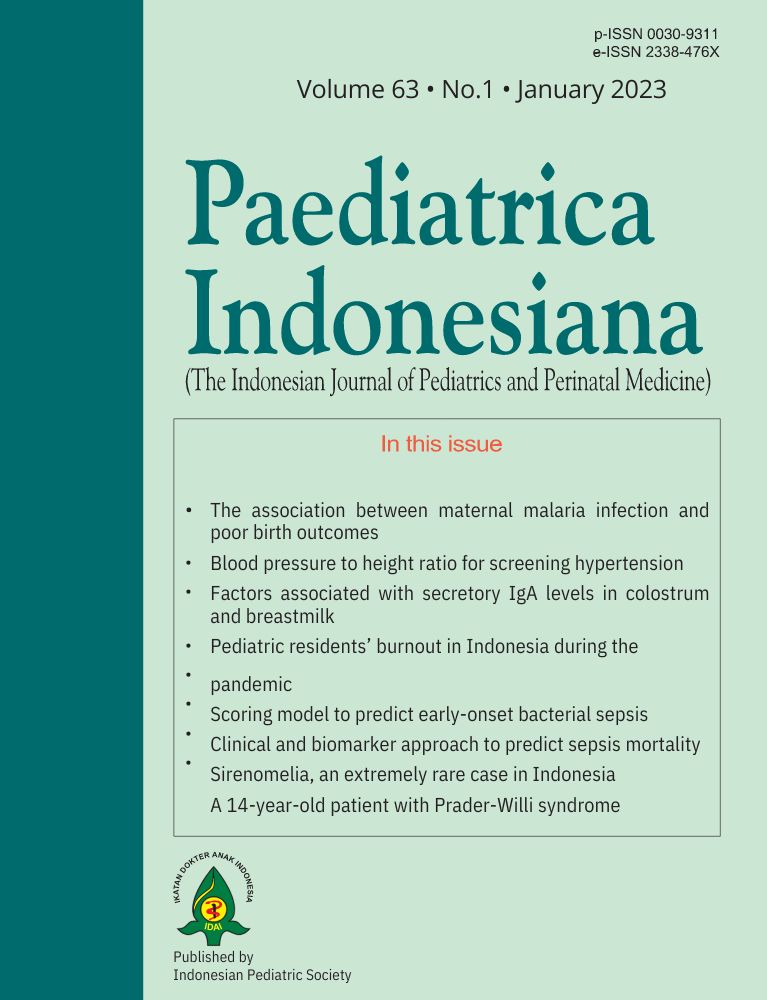A 14-year-old patient with Prader-Willi syndrome: a case report
DOI:
https://doi.org/10.14238/pi63.1.2023.51-6Keywords:
case report; Prader-Willi syndrome; hyperphagia; complications; multidisciplinary management; outcomeAbstract
Prader-Willi Syndrome (PWS) is a disorder resulting from a loss of genetic information on chromosome 15q11.2-q13 inherited from the father. It can be caused by paternal deletions (65-75%) or uniparental maternal disomy (20-30%). The prevalence of PWS is estimated to be 1/10,000 - 1/20,000 births.1 Although its incidence is relatively rare, PWS can cause major health problems for patients and decreased quality of life for their families.
The course of PWS is characterized by severe hypotonia in the neonatal period, severe feeding problems resulting in growth failure, as well as small hands and feet. Hypogonadism manifests as genital hypoplasia, delayed puberty, and infertility. Children with PWS have delayed motor and language development. Most patients have some degree of intellectual disability. Hyperphagia and obesity occur in early childhood. The patient’s excessive eating behavior affects the patient’s and family’s quality of life, and is often responsible for high morbidity and mortality.
References
2. UKK Endokrinologi Anak dan Remaja Ikatan Dokter Anak Indonesia. Konsensus nasional pengelolaan diabetes melitus tipe-2 pada anak dan remaja. Jakarta: Badan Penerbit IDAI; 2015. p.14.
3. UKK Nutrisi Dan Penyakit Metabolik Ikatan Dokter Anak Indonesia. Diagnosis, tatalaksana dan pencegahan obesitas pada anak dan remaja. Jakarta: Badan Penerbit IDAI; 2015. p.22-29.
4. Crinò A, Fintini D, Bocchini S, Carducci C, Grugni G. Prader–Willi syndrome: clinical problems in transition from pediatric to adult care. Research and Reports in Endocrine Disorders. 2016;6:49-57. DOI: https://doi.org/10.2147/RRED.S56401.
5. Carrel AL, Myers SE, Whitman BY, Allen DB. Benefits of long-term GH therapy in Prader-Willi Syndrome: a 4-year study. J Clin Endocrinol Metab. 2002;87:1581–5. DOI: https://doi.org/10.1210/jcem.87.4.8414.
6. Kherra S, Paterson WF, Cizmecioglu FM, Jones JH, Kourime M, Elsedfy HH, et al. Hypogonadism in Prader-Willi syndrome from birth to adulthood: a 28-year experience in a single centre. Endocrine Connection. 2021;10:1134-46. DOI: https://doi.org/10.1530/EC-21-0277.
7. Butler MG, Lee J, Manzardo AM, Gold J, Miller JL, Kimonis V, et al. Growth charts for non-growth hormone treated Prader-Willi syndrome. Pediatrics. 2015;135:e126–35. DOI: 10.1542/peds.2014-1711.
8. Butler MG. Management of obesity in Prader-Willi syndrome. Nat Clin Pract Endocrinol Metab. 2006;2:592–3. DOI: https/doi.org/10.1038/ncpendmet0320.
9. Scheimann AO, Butler MG, Gourash L, Cuffari C, Klish W. Critical analysis of bariatric procedures in Prader-Willi syndrome. J Pediatr Gastroenterol Nutr. 2008;46:80–3. DOI: https://doi.org/10.1097/01.mpg.0000304458.30294.31.
10. Donaghue KC, Wadwa RP, Dimeglio LA, Wong TY, Chiarelli F, Marcovecchio ML, et al. ISPAD Clinical Practice Consensus Guidelines 2014. Microvascular and macrovascular complications in children and adolescents. Pediatr Diabetes. 2014;15:257–69. DOI: https://doi.org/10.1111/pedi.12180.
11. Brambilla, P, Crinò A, Bedogni G, Bosio L, Cappa M, Corrias A, et al. Metabolic syndrome in children with Prader-Willi syndrome: The effect of obesity. Nutr. Metab. Cardiovasc. Dis. 2011;21:269–276. DOI: 10.1016/j.numecd.2009.10.004.
12. Printza N, Bersos E, Zafeiriou D, Leontsini M, Stamou M, Papachristou F. Mesangioproliferative glomerulonephritis in an infant with Prader-Willi syndrome. Hippokratia. 2009; 2:125-6. PMID: 19561787.
Downloads
Published
How to Cite
Issue
Section
License
Authors who publish with this journal agree to the following terms:
Authors retain copyright and grant the journal right of first publication with the work simultaneously licensed under a Creative Commons Attribution License that allows others to share the work with an acknowledgement of the work's authorship and initial publication in this journal.
Authors are able to enter into separate, additional contractual arrangements for the non-exclusive distribution of the journal's published version of the work (e.g., post it to an institutional repository or publish it in a book), with an acknowledgement of its initial publication in this journal.
Accepted 2023-02-28
Published 2023-02-28














